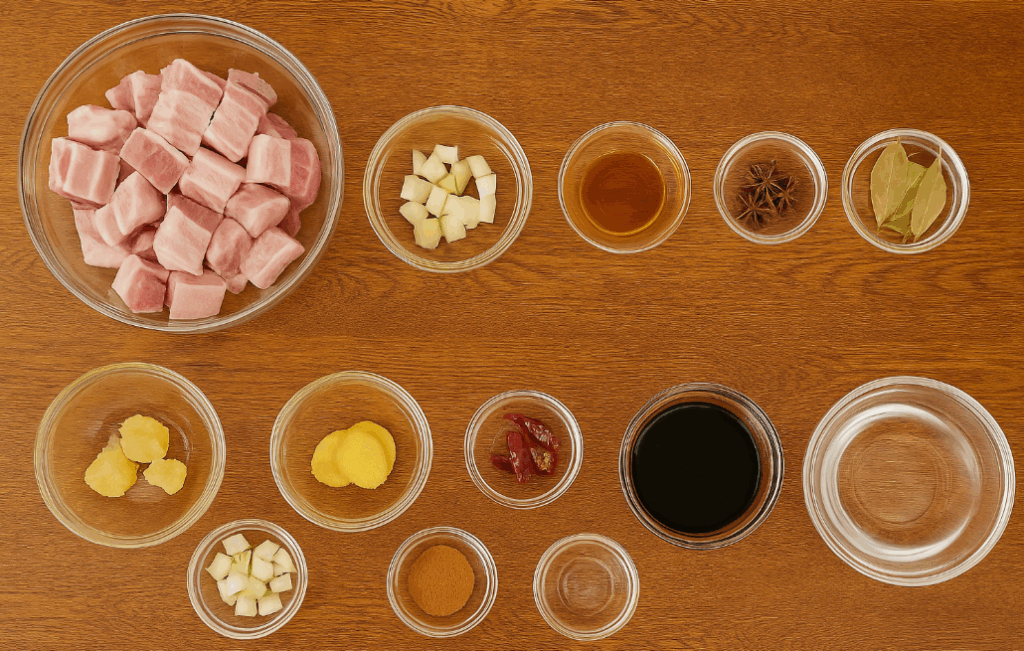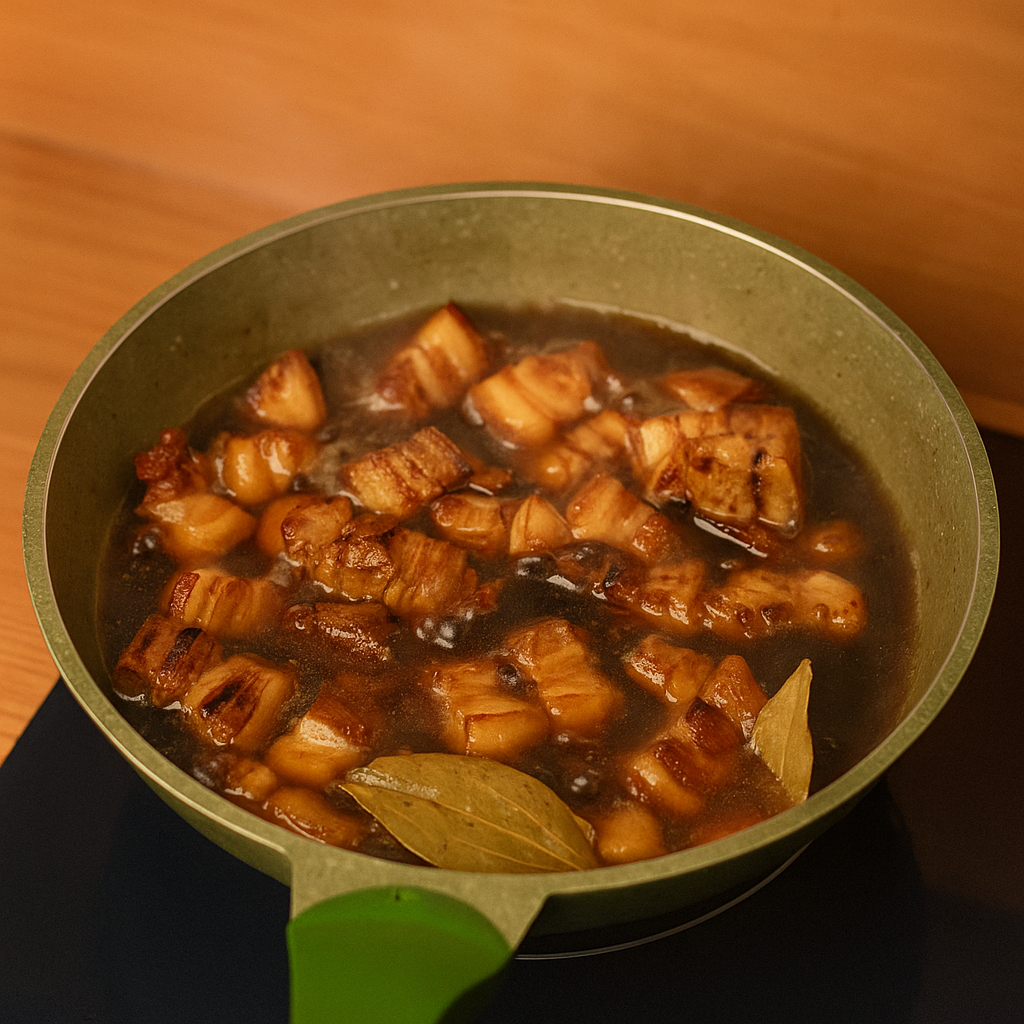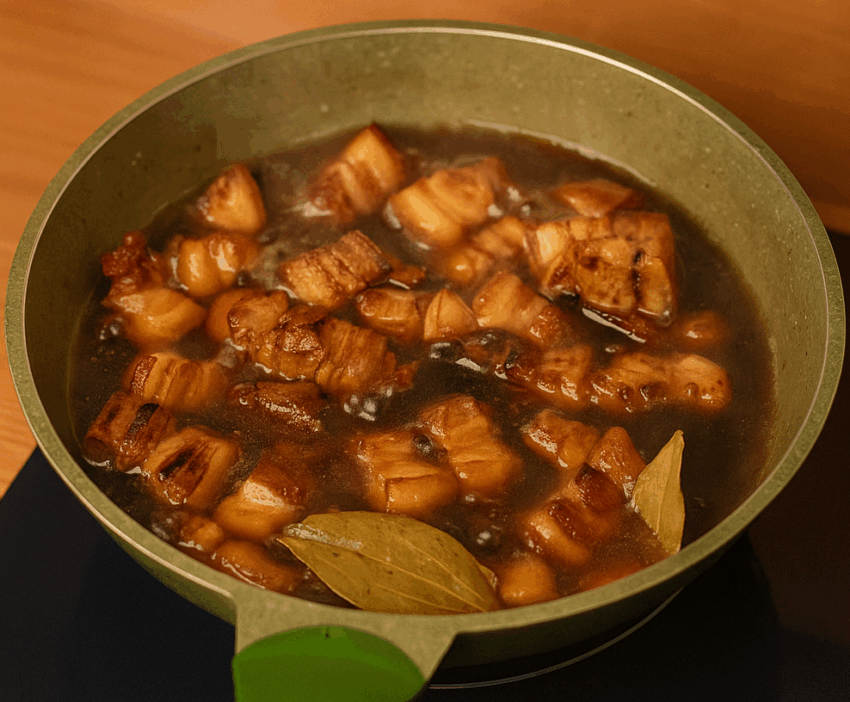Succulent, fatty meat that melts in your mouth, wrapped in a glossy, rich sauce – there’s no better way to describe Hong Shao Rou (red-braised pork belly). It’s a dish that’s equal parts comfort and indulgence, with deep soy flavors, warm spices and a hint of sweetness in every bite. Slow-cooked and caramelised to perfection, it’s a classic from Shanghai that proves some of the best meals are the ones that take their time. Here’s how you can make a delightful slow-cooked pork belly, Chinese style.
Ingredients
For the blanching process:
- 1.5 lbs pork belly cubed
- 2 scallions – white portion
- 3 slices ginger
- ¼ Shaoxing wine (substitute with sherry or dry rice wines)
For the cooking process:
- 2 tbsp rock sugar (use brown sugar if you don’t have it available)
- 3 scallions – white portion
- 2 star anise
- 3 slices ginger
- 1 cinnamon stick
- 2 bay leaves
- 3 dried chillies
- ¼ Shaoxing wine
- 3 tbsp light soy sauce
- 1 tbsp dark soy sauce
- 2.5 cups water

Blanching
Making a great Hong Shao Rou starts at the butcher’s counter. You’ll want to choose pork belly with a good balance of fat and lean meat. Traditionally, a 1:1 ratio of fat to lean is ideal as it’s what gives the dish its signature melt-in-your-mouth texture and rich flavour. The key is to avoid anything too lean, or you’ll miss out on that luscious braise.
Start by cutting your pork belly into bite-sized cubes – about 1 to 1.5 inches (2.5 to 3.5 cm) wide. Cut across the grain and keep the skin on, as it plays a big role in the final texture of the dish.
Next, it’s time to blanch the pork to remove impurities. Place the pork belly cubes in a pot along with a few slices of ginger, some scallions and a splash of Shaoxing wine. Cover everything with cold water, then bring it up to a gentle boil.
Once it hits a rolling boil, you’ll notice some scum and foam rising to the top. This is made up of blood proteins, excess fat and other impurities. Let it boil for 2 to 3 minutes, then drain and rinse the pork pieces under cold water to wash off any remaining residue.
Cooking
The main cooking method we are using is braising. It takes some time, but it’s the best method for ensuring a succulent, juicy bite of pork.
Heat oil and rock sugar in a large skillet (a wok is traditional, but any pan works). Crush the sugar slightly and stir until it melts into a golden caramel. This gives the dish its signature colour and sweetness. Add the pork belly and sauté until browned and fully coated in the melted sugar.
Now it’s time to add your aromatics: star anise, cinnamon sticks, bay leaves, dried chillies and a few slices of fresh ginger and scallions. Pour in Shaoxing wine, along with light and dark soy sauces for depth and colour. Then, add enough water to cover the pork.

Bring it all to a gentle simmer, cover and cook on low heat for about 1.5 hours until the pork becomes tender and the sauce thickens into a shiny, aromatic glaze. You can tell if the pork is cooked through properly if you can poke the skin with a fork easily.
You might wonder, “Doesn’t longer cooking cause the pork to become tough and chewy?” In fact, with pork belly, extended cooking is essential. This particular cut contains a high amount of fat and collagen-rich connective tissue, which require low, slow heat to fully break down. As it simmers, the collagen gradually converts into gelatin, creating that tender, unctuous texture Hong Shao Rou is known for. Unlike lean cuts that dry out quickly, fatty cuts actually improve with time.

Using a slotted spoon, remove all the spices and heat the pork and sauce without a lid until it thickens to a desired consistency. Your Hong Shao Rou is now ready.
Plating
Serve the pork belly with plenty of that rich, glossy sauce over a bowl of steamed jasmine rice.
Some dishes take a long time to cook and Hong Shao Rou is one of them. It’s not something you throw together on a busy weeknight, but that’s exactly what makes it special. From the slow caramelisation to the gentle braise, every step builds flavour and texture that you simply can’t rush.
If you’ve got a quiet afternoon and a little patience, this dish rewards you with something rich, comforting and deeply satisfying. Trust me, it’s worth every minute.

